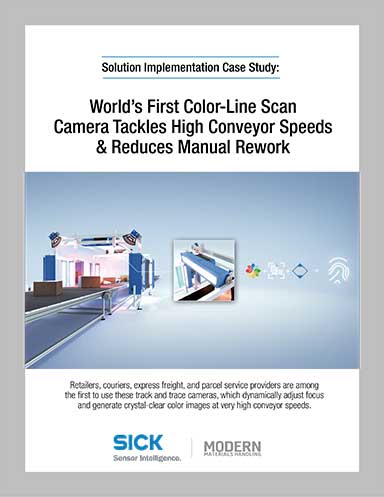Leaders Q&A: Deploying Intelligent Sensors to Improve Warehouse Operations
In this Leader’s Q&A, SICK USA president Dave Szczepanski discusses the current challenges in warehouse automation and how companies are using intelligent sensors to collect and use data.

Dave Szczepanski, President, SICK USA
In a world where the only real “sure thing” is uncertainty, companies are trying to figure out what’s coming next and adapting accordingly. With so much variability in the market—labor constraints, supply chain shortages, evolving customer demands and so forth—organizations are more closely examining their specific needs and making investments in warehouse automation that helps them operate more productively and with fewer resources.
Other companies are modifying their current fulfillment setups, redesigning their supply chains and adapting physical locations to meet their customers’ emerging demands. As president of SICK USA, Dave Szczepanski, understands the role that intelligent sensors have in helping companies optimize their warehouse automation investments and do more with the data that they collect on a daily basis.
In this Leader’s Q&A, Szczepanski discusses the current challenges facing warehouse operations, how intelligent sensors can help solve these challenges and the future of the automated warehouse or DC.
Q: What’s happening right now within the four walls of the typical warehouse or DC?
A: Automation in many forms continues to be adopted at a breakneck pace to address labor shortages, safety and efficiency interests of supply chain and material handling practitioners. The deployment of autonomous platforms and robotics are a key focus area because both provide quick return and efficiency gains. SICK is at the forefront of providing sensor-based solutions that ensure safe, efficient deployment of OEM systems designed to bring automation into traditionally manual or low automation operations.
We’re also seeing a “melding” of what our customers are doing in the industry, as in there’s no longer just manufacturing or logistics; they’re handling both. As a result, we’re starting to see the breadth of their automation portfolios increasing to ensure that they hit the desired service levels.
In a world where the only real “sure thing” is uncertainty, companies are trying to figure out what’s coming next and adapting accordingly. With so much variability in the market—labor constraints, supply chain shortages, evolving customer demands and so forth—organizations are more closely examining their specific needs and making investments in warehouse automation that helps them operate more productively and with fewer resources.
Q: What challenges are companies facing in this environment?
A: Users are seeking rapid deployment of automation without disruption to ongoing operations. Quick service turnaround and turnkey solutions with reliable support, product delivery and maintenance capabilities minimize downtime and optimize throughput. Meeting consumer expectations amid high competitive pressure for market share/competitive advantage is a key goal of SICK’s customers and we’re equipped to help them on that journey.
Q: How do intelligent sensors help tackle these challenges and remain competitive?
A: Sensor intelligence continues to be at the heart of automation functionality because the sensor is at the base of data collection. More importantly, the data itself has to be usable and actionable. SICK has taken steps to ensure added features and functionality at the sensor level, but is also leveraging critical data for supply chain visibility and condition monitoring for safe and efficient operations. Simplifying integration, use and maintenance in OEM systems is one of our focuses because it provides user value and a competitive edge.
Q: What does the future hold for automated warehouse and DC operations?
A: The future is taking shape as we speak with the adoption of new material handling modes whether by enhancing traditional means (i.e., conveyors) or adapting new means (i.e., hybrid conveyance, mobile automation and robotic platforms). Higher throughput, flexibility in design and safety are all focus areas in the industry. We’re also working to solve shippers’ last-mile delivery challenges. That could mean using automation and backup stores, or it could mean smaller buildings, based on location (e.g., New York City versus the suburbs). That delivery difference presents a big challenge, and we’re tweaking our designs in a way that increases flexibility based on each physical location’s last-mile challenges.
Q: What else is SICK doing to prepare itself and its customers for the future?
A: We continue to invest in customer-centric solutions and partnerships that provide world-class value. We’re expanding our North American footprint with a new US headquarters in Bloomington, Minn., that houses state-of-the-art manufacturing to address local demand. We’re also expanding our workforce in all areas, including sales, tech support and field service. SICK has cultivated a culture and environment of experts that work collaboratively with its customers and has consistently been named a “Best Place to Work.” We’ll be highlighting our new technology solutions at ProMat 2023. Swing by our booth (S3831) to learn more.














